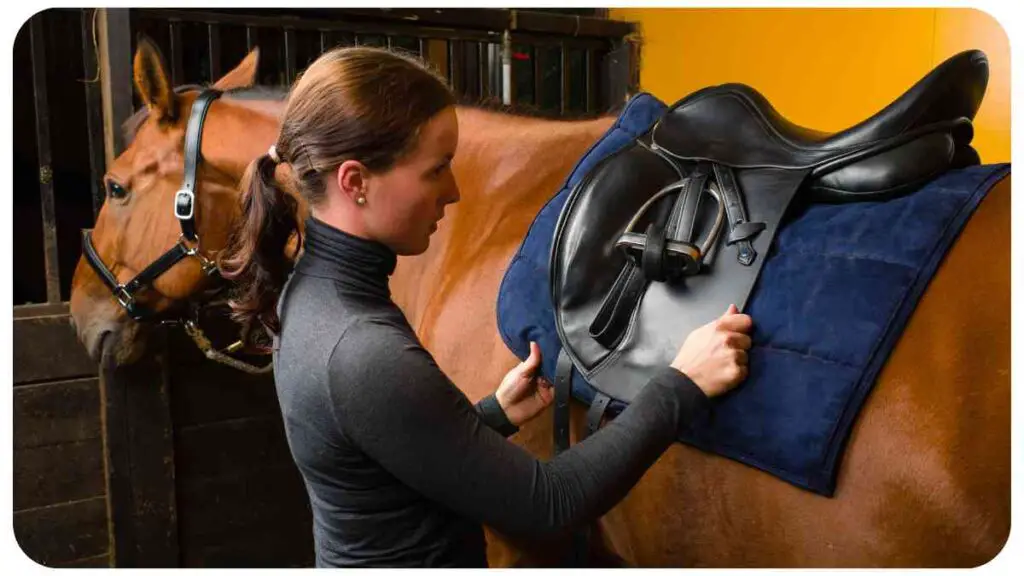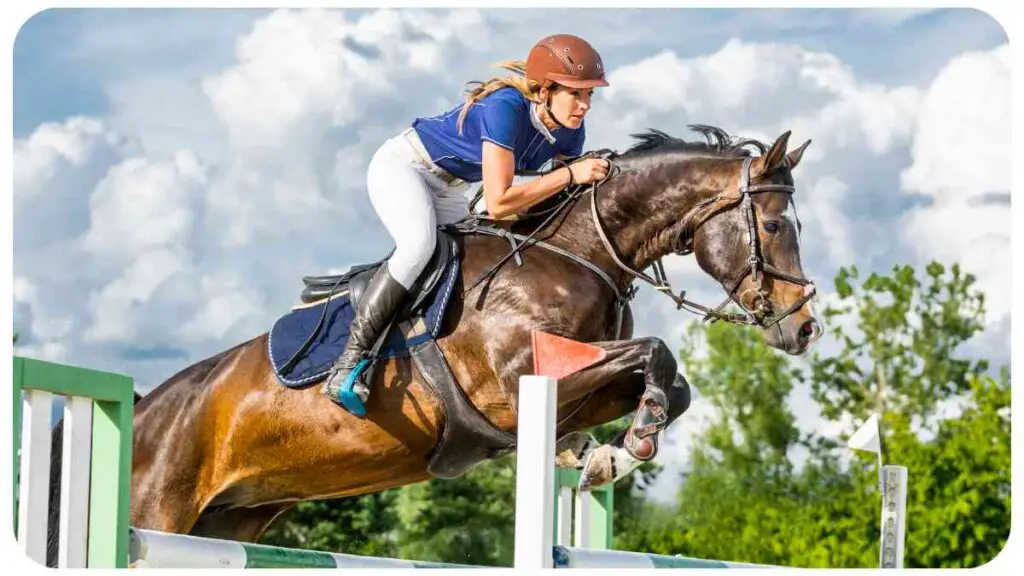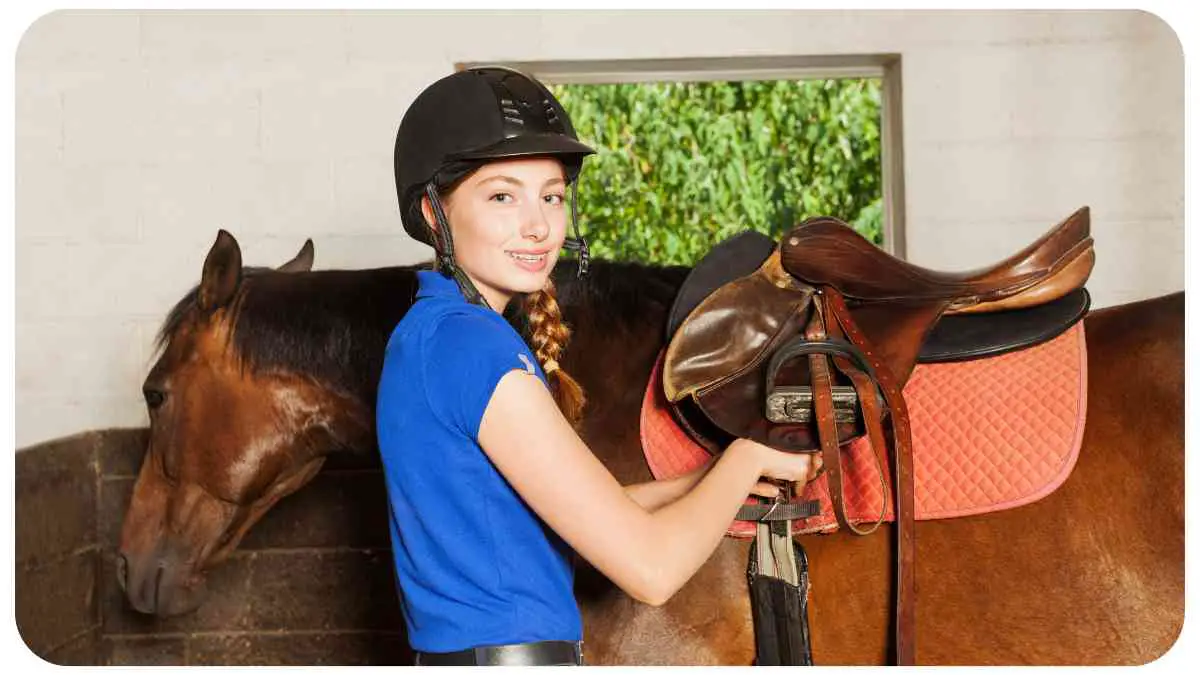In the equestrian world, correct saddle fitting is crucial for both the comfort of the rider and the welfare of the horse. A well-fitted saddle can greatly enhance the riding experience, allowing both horse and rider to perform at their best.
This article aims to explore the pros, cons, and tips associated with saddle fitting to help riders make informed decisions when selecting and assessing saddles.
| Takeaway |
| Proper saddle fitting is essential for horse and rider comfort. |
| Poor saddle fit can cause discomfort and restrict movement. |
| Regular saddle fit assessment is important as horses change. |
| Seeking professional guidance can help achieve optimal fit. |
| Using appropriate saddle pads can improve comfort and fit. |
2. The Importance of Correct Saddle Fitting
Proper saddle fit is essential for several reasons. Firstly, it ensures the horse’s comfort and well-being by eliminating unnecessary pressure points and excessive movement of the saddle on the horse’s back.
Secondly, it promotes optimal rider position, balance, and stability, allowing for effective communication between the horse and rider. By maintaining a secure seat, riders can ride with confidence and harmony.
In order to ensure a comfortable and well-fitting saddle, it is crucial to consider various factors such as choosing the perfect saddle. Understanding your horse’s conformation, discipline, and personal preferences will guide you in making the right choice
3. Signs of Poor Saddle Fit
Identifying signs of poor saddle fit is crucial to rectify any issues promptly. Some common indications include:
- Uneven sweat patterns under the saddle pad
- Restricted shoulder movement or muscle atrophy
- White or bald patches on the horse’s back
- Behavioral changes, such as bucking or resistance while riding If you notice any of these signs, it’s time to reassess the saddle fit to prevent discomfort and potential long-term damage.
4. Pros and Benefits of Proper Saddle Fit

Investing in correct saddle fitting yields numerous advantages for both horse and rider. Let’s explore some of these benefits:
Table: Benefits of Correct Saddle Fitting
| Benefit | Description |
| Enhanced Comfort | Properly fitting saddles alleviate pressure points on the horse’s back, providing greater comfort. |
| Improved Performance | A well-fitted saddle allows the horse to move freely and perform optimal movements. |
| Better Communication | Rider’s aids are conveyed more effectively with a balanced and secure seat, leading to clearer cues. |
| Injury Prevention | Correct saddle fit minimizes the risk of soreness, back pain, and long-term musculoskeletal issues. |
| Longer Riding Sessions | Comfortable horses tend to have longer endurance and can engage in more extended riding activities. |
5. Cons and Risks of Improper Saddle Fit
Conversely, inadequate saddle fit can lead to a variety of problems for both horse and rider. It’s important to be aware of the risks associated with improper saddle fit:
When it comes to horseback riding, having the right equipment is essential. One vital piece is the bridle, and finding the best horseback riding bridles for your specific discipline will enhance your communication with your horse and improve your riding experience.
Table: Risks of Incorrect Saddle Fitting
| Risk | Description |
| Discomfort and Pain | Ill-fitted saddles create pressure points, leading to discomfort and potential pain in the horse. |
| Restricted Movement | A poorly fitting saddle restricts the horse’s natural range of motion, hindering performance. |
| Decreased Rider Stability | Riders may struggle with balance and stability if the saddle doesn’t fit their body correctly. |
| Musculoskeletal Complications | Long-term use of an ill-fitting saddle can contribute to muscle atrophy and back-related issues. |
| Impaired Communication | Inadequate saddle fit hampers clear and effective communication between the horse and the rider. |
6. Tips for Achieving Proper Saddle Fit
When aiming for correct saddle fitting, certain factors need to be considered. Here are some essential tips to keep in mind:
Table: Factors to Consider for Saddle Fit
| Factor | Description |
| Horse’s Conformation | Each horse has a unique body shape, and the saddle needs to fit their conformation to optimize comfort and freedom of movement. |
| Rider’s Position | The saddle should facilitate the rider’s position by allowing an aligned and balanced seat. |
| Tree Size and Shape | The saddle tree, which forms the foundation, should match the horse’s back and wither shape for proper weight distribution. |
| Gullet Width | The gullet width should provide sufficient clearance above the horse’s spine, ensuring no pressure or rubbing occurs. |
| Panel Design | The panels should evenly distribute the rider’s weight, avoiding excessive pressure points and discomfort on the horse’s back. |
| Saddle Pad Selection | Choosing the right saddle pad helps absorb shock, provides additional cushioning, and promotes proper saddle fit. |
| Regular Evaluation | Ongoing assessment and adjustment are necessary as the horse’s body shape or the rider’s needs may change over time. |
By considering these factors, riders can ensure a more tailored and suitable saddle fit for their specific needs.
7. Understanding Saddle Tree Sizes and Shapes
Saddle trees play a pivotal role in determining the fit and comfort of a saddle. The size and shape of the saddle tree should correspond to the horse’s back and wither structure. Common tree sizes include narrow, medium, wide, and extra-wide, catering to different horse conformations. Working with a knowledgeable saddle fitter or expert can help determine the appropriate tree size and shape for your horse.
Properly fitting horseback riding boots play a significant role in both comfort and safety. Understanding the importance of properly fitting horseback riding boots will help you avoid discomfort, prevent accidents, and enable better control while riding
8. Assessing Saddle Balance
Saddle balance refers to the distribution of weight across the horse’s back. An imbalanced saddle can cause discomfort and interfere with the horse’s movement. To determine proper balance, place the saddle on the horse without a pad and ensure it sits evenly from front to back. Assessing the balance while mounted is also important, as it ensures the rider’s weight is equally distributed.
Table: Saddle Balance Assessment
| Balance | Description |
| Front-Heavy | Saddle tilts forward, putting excessive pressure on the horse’s withers. |
| Back-Heavy | Saddle tilts backward, exerting undue pressure on the horse’s loins and disrupting balance. |
| Centered and Balanced | Saddle sits level without tipping forward or backward, distributing the rider’s weight evenly. |
9. Adjusting the Saddle Pad
Saddle pads serve as a protective layer between the horse and the saddle. They help absorb moisture, cushion impact, and contribute to proper saddle fit. Different types of saddle pads are available, including fleece, gel, and foam. Experimenting with various pad options and ensuring correct pad placement can enhance saddle fit and alleviate pressure points.
To truly understand horseback riding, it is essential to delve into its rich history. Exploring the history of horseback riding and its evolution over time provides valuable insights into the traditions, developments, and influences that have shaped this timeless equestrian activity.”
Table: Types of Saddle Pads
| Pad Type | Description |
| Fleece pads | Provide soft cushioning and moisture-wicking properties, suitable for horses with minimal saddle fit issues. |
| Gel pads | Offer additional shock absorption and conform to the horse’s back, providing extra support and comfort. |
| Foam pads | Lightweight and versatile, foam pads can be used alone or layered with other pads to customize the fit and balance as needed. |
| Therapeutic pads | Designed for therapeutic purposes, these pads often incorporate specialized materials or features to address specific concerns. |
Remember that choosing the right saddle pad for your horse can greatly contribute to overall saddle fit and comfort.
10. Seeking Professional Assistance

Achieving the perfect saddle fit can be a challenging task, especially for those new to the process. Seeking guidance from a professional saddle fitter or knowledgeable equestrian can provide valuable insights and expertise. These experts can assess your horse’s conformation, evaluate saddle fit, and make necessary adjustments to ensure optimal comfort and performance.
Personal Experience: Anecdotes and Insights
Throughout my years as a professional equestrian, I have encountered numerous challenges when it comes to saddle fitting. One particular incident stands out in my memory. I was struggling with my horse’s performance and noticed signs of discomfort during our rides. After seeking the help of a saddle fitter, I realized that the saddle I had been using didn’t properly accommodate my horse’s conformation. With the expert’s guidance, I was able to find a saddle that provided a better fit, resulting in improved performance and a happier horse.
From this experience, I learned that saddle fitting is a constant process. As horses develop and change over time, their saddle needs can also evolve. Regular evaluation and adjustments are vital to ensure the horse’s comfort and prevent any potential issues.
Safety is paramount when it comes to horse riding. Equipping yourself with the right gear is crucial, and knowing the top 15 pieces of safety equipment every rider needs ensures you are well-prepared for any potential risks, promoting a secure and enjoyable riding experience
11. Conclusion
Correct saddle fitting is an essential aspect of horse riding that should not be overlooked. By prioritizing the horse’s comfort and taking into account factors such as conformation, balance, and saddle pad selection, riders can optimize the riding experience and enhance communication with their equine partner.
Regular evaluation of saddle fit and seeking professional guidance when needed are key to maintaining optimal saddle fit over time. Remember, a well-fitted saddle not only benefits the horse’s well-being but also contributes to the rider’s stability, performance, and overall enjoyment of the equestrian journey.
Incorporate these tips, draw from personal experience, and forge ahead with confidence in the saddle!
Further Reading
Here are some additional resources to explore for more information on correct saddle fitting:
- Saddle Fitting Guide by SmartPak Equine: This comprehensive guide provides detailed insights and tips on saddle fitting, covering various aspects such as saddle fit assessment, common problems, and solutions.
- Saddle Fitting: How to Choose the Correct Saddle for a Horse and Rider by Equishop: Equishop’s blog post dives into the intricacies of saddle fitting, offering guidance on selecting the right saddle for both horse and rider, considering factors like shape, size, and materials.
- Tips & Tricks for Saddle Fitting by Starlit Ridge: Starlit Ridge shares practical tips and tricks for achieving proper saddle fit, providing insights into common challenges faced during the fitting process and how to overcome them effectively.
These resources can offer further in-depth information and different perspectives on the topic of saddle fitting.
FAQs
What are the common signs of poor saddle fit?
Signs of poor saddle fit include uneven sweat patterns under the saddle pad, restricted shoulder movement or muscle atrophy, white or bald patches on the horse’s back, and behavioral changes such as bucking or resistance while riding.
How often should I assess my horse’s saddle fit?
Regular assessment of saddle fit is recommended, especially if you notice any changes in your horse’s physique or behavior. Factors such as growth, weight loss, or changes in muscle tone can affect the fit, so it’s essential to evaluate the saddle’s suitability periodically.
How do I determine the proper saddle tree size?
Finding the right saddle tree size involves considering your horse’s conformation and wither shape. Working with a knowledgeable saddle fitter or expert can help ensure the correct measurement and selection of the saddle tree that suits your horse’s specific requirements.
Can using a saddle pad help improve saddle fit?
Yes, using a suitable saddle pad can enhance saddle fit and provide additional cushioning and shock absorption. Different types of saddle pads, such as fleece, gel, or foam pads, offer various benefits and can contribute to overall comfort and proper saddle fit.
When should I seek professional assistance for saddle fitting?
If you’re unsure about saddle fit or encountering persistent issues, it’s advisable to seek professional assistance from a saddle fitter or equestrian expert. They possess the expertise to evaluate your horse’s conformation, identify any fitting issues, and make appropriate recommendations or adjustments to ensure optimal saddle fit.

Hi there! My name is Hellen James, and I’m a horse riding expert. I’ve been riding horses since I was just a kid—and it’s been my passion ever since. But getting started with horse riding can be overwhelming. There’s so much to learn! If you’re looking for a way to get started and make sure you’re doing it right, I’m here to help.

